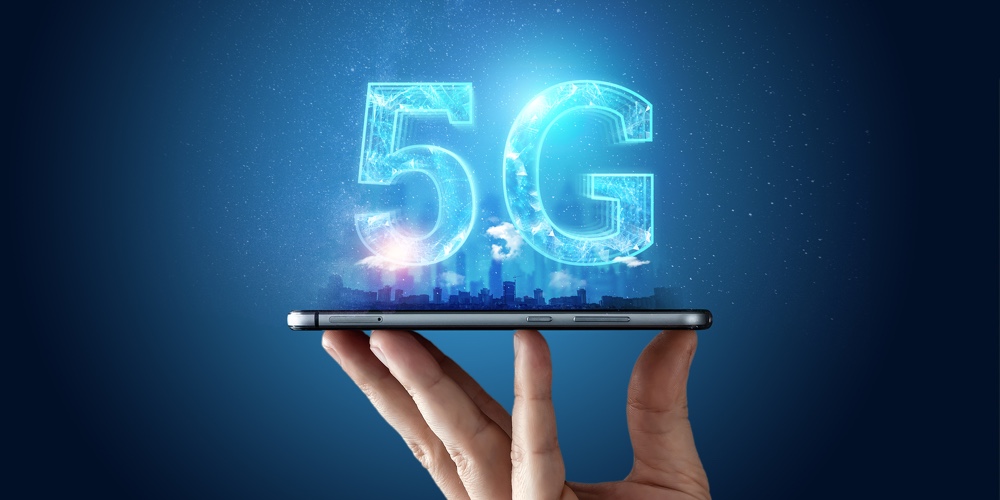5G doesn’t matter

Hey again! It’s your friendly neighborhood Credit Union Geek, talking about the latest webs making their way through your community. Silk-free, of course. We don’t need those strands sticking to everyone. This is an invisible new tech that could change everything.
Or it could just be an evolutionary improvement that enables new capabilities for a range of industries. You decide.
Today we’re going to talk about 5G. Some say it will revolutionize banking. And e-commerce. And medicine. Basically, everything!
Others think it caused COVID-19. They’re wrong, just to be clear.
Join me for a few geeky minutes and we’ll figure out how 5G may, or may not, affect your credit union. And how you can prepare!
What Is 5G?
This isn’t a place to go into deep technical dives. Besides, there are people out there far more qualified than I to lead you on that journey. You want to know the basics. Here we go.
Take out your phone. Maybe it’s an iPhone. Perhaps it’s a Samsung Android-powered device. Whatever it is, I guarantee it connects to a cell tower to work. Sure, with work-from-home, we’re using a lot more wifi, but that doesn’t mean mobile providers are sitting still.
Take a look at the top of the display. There’s some signal bars and maybe a network name. Next to it, you might see a “3G”, “4G”, “LTE”, or something similar. (AT&T users probably see “5Ge”, which is a total lie done for marketing purposes only)
Most of the time, our devices are on an LTE network. That’s considered a 4th generation wireless technology, thus, “4G” is the same thing. It’s fast and does a pretty good job of working where we commonly go.
Sidenote: Yes, there are variations of 4G LTE like LTE Advanced, but remember I said this was a basic overview?
Like most technology, LTE was never seen as “the end of the line”. Even while it was being deployed, companies were working together to design the next generation of cellular tech. What came out of that collaboration is what we now call “5G”.
5G cellular technology promises a few things:
-
Faster speeds
-
More concurrent users
-
Lower latency
-
Improved security
-
Potential interference with weather satellites (it’s probably a nonissue, but also an interesting physics primer)
Ok, barring that last one, those all seem great. Let’s do it! I’m sure there’s no challenges standing in our way…
Challenges of Implementing 5G
Well, I did bring it up.
Like LTE’s deployment before, blanketing a country (or world) in a new technology is a huge undertaking. Even for companies like Verizon which make a ton of money, you’re still talking enormous investments in equipment, people, licensing, and sheer time.
Bottom line: Every single cell tower (and its “backhaul”, or lines connecting it to the world) needs to be upgraded to support 5G. And that’s not all.
5G is actually separated into two general categories, mmWave and “regular” 5G. The latter is mostly a “bolt-on” upgrade to existing towers, using similar frequencies and offering similar range. But they’re also only slightly faster than what we have today with LTE.
The 5G you see promoted by networks as “nationwide coverage” is the latter. Expect the improvements in each of the previous categories to be…a bit.
The big benefits come from mmWave, but it has a downside: Range. Just like an AM radio station carries for what seems like forever while an FM station goes to static quickly, the higher a frequency, the shorter its range. So short, it could only be a city street corner.
Yes, that means you need a cell “tower” (they’re smaller) on every block, and then multiple ones for a building.
Why bother?
Because mmWave 5G is fast. And extremely low-latency (quick response between device and destination). This can enable new uses, from drones to live VR and more. Right now, we are still figuring out what opportunities it opens up.
One More 5G Challenge
Your current device doesn’t work with 5G. Unless you have a new Android or iPhone 12, you’ll never experience the benefits of 5G. Sure, you will have a less congested network as other people transition to 5G, but you’re stuck on 4G LTE. Enjoy the “slow” lane, suckers!
Needless to say, from your perspective as someone not involved in the deployment of a nationwide network, consumer adoption is your greatest obstacle.
Ok, say we’re enjoying the iPhone 12 Pro right now. And I happen to live somewhere that 5G mmWave is accessible, plus, I choose not to use my home wifi (that’s probably about the same speed). How can this make my credit union experience better?
Uses for Credit Unions and Members
Finally, why you came to this party! And after all that education, you’re going to hate this answer, but it’s my responsibility to share it with you.
None.
There is no realistic use of 5G now or in the immediate future for credit unions.
“But I keep seeing articles saying how 5G will change the way credit unions operate!” You’re right. I applaud these people for looking ahead with new ideas. Yet none of them are dependent on 5G. I’ll address just a few here:
-
Improved biometrics for security: Position data of a device takes a tiny amount of information to store and process.
-
With an iPhone, you can even see data on every step you’ve ever taken in Settings/Health/Data Access & Devices, then choose your phone or watch.
-
This information also requires permission to share, and how many members will say yes to their credit union seeing their motion activity?
-
-
Real-time language translation: Your iPhone does this right now, with the option for it to be totally on-device. No data connection even necessary!
-
Facial recognition: The idea is that your system can get a stream from the camera to identify the user and their facial expressions.
-
First, modern iPhones do all this on-device. Today. No need for 5G. Second, people aren’t fond of sending video of them without explicit permission (that’s why your phone now shows a green dot when it’s recording)
-
And third, you’re now responsible for securing member facial data and all the legal/regulatory issues associated. Any volunteers?
-
That’s not to mention the enormous data usage your app would now use, along with members wondering why your app asks for permission to use the camera.
-
-
Video chat with members: Yeah, you can totally do that right now with WiFi and LTE. Don’t you already?
-
Faster loan approvals: What’s the slowest part of your loan process? The sending of the data, or the processing on your system (or the manual work from your loan officers)? Yeah, sending documents a half-second faster won’t change this.
We could go on, but I think you have the point.
Instead of looking at 5G as this revolutionary change to how you can do business, let’s look at where you aren’t meeting member expectations today. Because that’s the most important path towards becoming a better community financial institution.
Lessons From 5G
Since we’ve already established that the tech itself has minimal impact on your operation, what can we learn? Well, two things come to mind:
-
Data management
-
Continuous improvement
Data Management
5G is all about moving data more efficiently. At your credit union, your focus needs to be on managing all your data more efficiently. That way, you can access what you need, when you need it.
You’ve probably heard about “data lakes” and “single source of truth”. In fact, our own Learning Library is gearing up to cover these topics in depth. A friend in the industry, Anne Legg, is all about that process. Other old friends at Arkatecture help make it happen.
It’s essential to improving your member experience.
Which brings us to the second lesson…
Continuous Improvement
Mobile providers aren’t satisfied with “same”. To grow revenues and attract new customers, they look ahead to how they can continuously provide a better service. Sure, a lot of it comes down to marketing, but if you don’t give marketing anything to promote, it’s more difficult.
5G comes at an enormous investment from the providers and chipset manufacturers. Then you have to redesign devices so they’ll work with the new tech. It’s way more complicated than you’d expect, but it continues the onward march of technology.
Yet being able to say your network is faster, you can do more with Verizon (or T-Mobile, etc.) than ever before, and that they are connecting you in new ways has value. And then they deliver on the promise with actionable results (like blazing-fast speed tests!).
5G May Not Matter, But…
So, how are you creating your own “5G improvements” at your credit union? What new ways can members interact with their money, connect with your team, and work towards a more financially free and empowered life?
And what are you doing to bring all your data together so anyone can get the info they need? Yes, whether they are using wifi, a back office computer, 4G LTE, or the fancy new 5G mmWave on the corner of fast and blazing fast.
Your mission is your 5G. And better access for all sounds like a good benefit to me.





